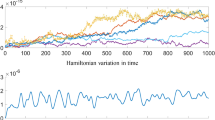Abstract
The Clebsch method provides a unifying approach for deriving variational principles for continuous and discrete dynamical systems where elements of a vector space are used to control dynamics on the cotangent bundle of a Lie group via a velocity map. This paper proves a reduction theorem which states that the canonical variables on the Lie group can be eliminated, if and only if the velocity map is a Lie algebra action, thereby producing the Euler–Poincaré (EP) equation for the vector space variables. In this case, the map from the canonical variables on the Lie group to the vector space is the standard momentum map defined using the diamond operator. We apply the Clebsch method in examples of the rotating rigid body and the incompressible Euler equations. Along the way, we explain how singular solutions of the EP equation for the diffeomorphism group (EPDiff) arise as momentum maps in the Clebsch approach. In the case of finite-dimensional Lie groups, the Clebsch variational principle is discretized to produce a variational integrator for the dynamical system. We obtain a discrete map from which the variables on the cotangent bundle of a Lie group may be eliminated to produce a discrete EP equation for elements of the vector space. We give an integrator for the rotating rigid body as an example. We also briefly discuss how to discretize infinite-dimensional Clebsch systems, so as to produce conservative numerical methods for fluid dynamics.
Similar content being viewed by others
References
M. A. Austin, P. S. Krishnaprasad, and L.-S. Wang, Almost Poisson integration of rigid body systems, J. Comput. Phys. 107(1) (1993), 105–117.
A. M. Bloch, P. E. Crouch, J. E. Marsden, and T. S. Ratiu, Discrete rigid body dynamics and optimal control, in Proceedings of CDC IEEE (1998).
N. Bou-Rabee and J. E. Marsden, Reduced Hamilton–Pontryagin variational integrators (2007, submitted).
T. J. Bridges and S. Reich, Multi-symplectic integrators: numerical schemes for Hamiltonian PDEs that conserve symplecticity, Phys. Lett. A 284 (2001), 184–193.
H. Cendra and J. E. Marsden, Lin constraints, Clebsch potentials and variational principles, Physica D 27 (1987), 63–89.
C. J. Cotter, D. D. Holm, and P. E. Hydon, Multisymplectic formulation of fluid dynamics using the inverse map, Proc. Roy. Soc. A 463 (2007), 1671–2687; http://arxiv.org/abs/math.DS/0702827.
D. D. Holm, Euler–Poincaré dynamics of perfect complex fluids, in Mechanics and Dynamics: Volume in Honor of the 60th Birthday of J.E. Marsden, pp. 113–167, Springer, Berlin, 2002.
D. D. Holm and B. A. Kupershmidt, Poisson brackets and Clebsch representations for magnetohydrodynamics, multifluid plasmas and elasticity, Physica D 6(3) (1983), 347–363.
D. D. Holm and J. E. Marsden, Momentum maps & measure valued solutions of the Euler–Poincaré equations for the diffeomorphism group, Progr. Math. 232 (2004), 203–235; http://arxiv.org/abs/nlin.CD/0312048.
D. D. Holm, J. E. Marsden, and T. S. Ratiu, The Euler–Poincaré equations and semidirect products with applications to continuum theories, Adv. Math. 137 (1998), 1–81; http://arxiv.org/abs/chao-dyn/9801015.
A. Iserles, On Cayley-transform methods for the discretization of Lie-group equations, Found. Comput. Math. 1(2) (2001), 129–160.
B. Leimkuhler and S. Reich, Simulating Hamiltonian Dynamics, Cambridge University Press, Cambridge, 2005.
A. Lew, J. E. Marsden, M. Ortiz, and M. West, An overview of variational integrators, in Finite Element Methods: 1970s and Beyond, ed. by L. P. Franca, CIMNE, Barcelona, Spain, 2003, pp. 85–146.
D. Lewis and J. C. Simo, Conserving algorithms for the dynamics of Hamiltonian systems on Lie groups, Nonlinear Sci. 4(1) (1994). 253–299.
H. Munthe-Kaas, Runge–Kutta methods on Lie groups, BIT Numer. Math. 38(1) (1998), 92–111.
R. L. Seliger and G. B. Whitham, Variational principles in continuum mechanics, Proc. Roy. Soc. A 305 (1968), 1–25.
J. Serrin, Mathematical principles of classical fluid mechanics, in Handbuch der Physik, pp. 125–263, Springer, Berlin, 1959.
H. Yoshimura and J. E. Marsden, Dirac structures in Lagrangian mechanics, part I: Implicit Lagrangian systems, J. Geom. Phys. 57 (2006), 133–156.
Author information
Authors and Affiliations
Corresponding author
Additional information
Communicated by Arieh Iserles.
Rights and permissions
About this article
Cite this article
Cotter, C.J., Holm, D.D. Continuous and Discrete Clebsch Variational Principles. Found Comput Math 9, 221–242 (2009). https://doi.org/10.1007/s10208-007-9022-9
Received:
Revised:
Accepted:
Published:
Issue Date:
DOI: https://doi.org/10.1007/s10208-007-9022-9




